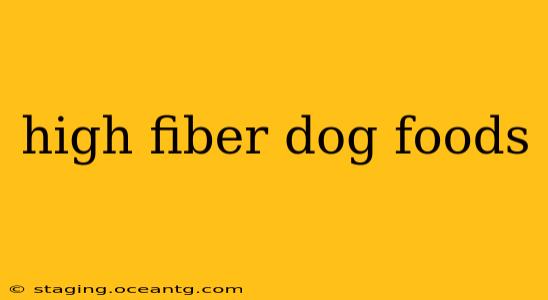Choosing the right dog food can be a daunting task, especially when considering specific dietary needs. For dogs experiencing digestive issues or those simply benefiting from added fiber, understanding the benefits and selecting a high-fiber dog food is crucial. This comprehensive guide will delve into the importance of fiber in canine nutrition, explore different types of fiber, and help you choose the best high-fiber dog food for your furry friend.
Why is Fiber Important for Dogs?
Fiber, a type of carbohydrate the body can't digest, plays a vital role in maintaining a healthy digestive system for dogs. It acts as a prebiotic, feeding beneficial bacteria in the gut and promoting a balanced microbiome. This balanced microbiome is key to optimal digestion, nutrient absorption, and overall health. The benefits extend beyond just digestion; fiber can also help regulate bowel movements, preventing constipation and diarrhea. For dogs prone to these issues, a high-fiber diet can be transformative.
What are the Different Types of Fiber in Dog Food?
Not all fiber is created equal. Understanding the different types of fiber found in dog food is important for making informed choices.
Soluble Fiber: This type of fiber dissolves in water, forming a gel-like substance that can help slow down digestion and regulate blood sugar levels. Sources include oats, barley, psyllium husk, and apples.
Insoluble Fiber: This fiber doesn't dissolve in water and adds bulk to the stool, promoting regularity. Sources include wheat bran, cellulose, and certain vegetables.
A balanced high-fiber dog food will ideally contain a mix of both soluble and insoluble fibers for optimal digestive benefits.
What are the Benefits of Feeding High-Fiber Dog Food?
The benefits of incorporating high-fiber dog food into your canine companion's diet are numerous:
- Improved Digestion: Fiber promotes healthy bowel movements, reducing constipation and diarrhea.
- Weight Management: High-fiber foods can help dogs feel fuller for longer, potentially aiding in weight loss or maintenance.
- Blood Sugar Regulation: Soluble fiber can help regulate blood sugar levels, which is particularly important for dogs with diabetes or those at risk.
- Enhanced Gut Health: Fiber feeds beneficial gut bacteria, strengthening the microbiome and improving overall digestive health.
- Reduced Risk of Certain Diseases: A healthy gut is linked to a reduced risk of various health problems.
How Much Fiber Does My Dog Need?
The optimal amount of fiber for your dog depends on several factors, including breed, age, size, activity level, and overall health. Always consult with your veterinarian before making significant changes to your dog's diet, especially if they have pre-existing health conditions. They can help determine the appropriate fiber intake for your dog's individual needs. Generally, dog foods marketed as "high-fiber" will contain a higher percentage of fiber than standard dog food options. Look at the ingredient list and nutritional information to gauge the fiber content.
What are the Signs of a Fiber Deficiency in Dogs?
While fiber deficiency isn't as commonly discussed as other nutritional deficiencies, it can manifest in several ways:
- Constipation: This is a major indicator of insufficient fiber intake.
- Diarrhea: Ironically, inadequate fiber can also contribute to diarrhea, as it doesn't add enough bulk to the stool.
- Bloating and Gas: An imbalanced gut microbiome can lead to these symptoms.
- Weight Gain: Lack of fiber can affect satiety, leading to increased food intake and potential weight gain.
- Lethargy and Fatigue: Digestive problems can impact overall energy levels.
What are Some Good High-Fiber Dog Foods?
Many commercial dog foods are specifically formulated to be high in fiber. Always check the ingredient list and nutritional information on the packaging. Look for dog foods that include ingredients like:
- Whole grains: Oats, barley, brown rice
- Vegetables: Sweet potatoes, peas, carrots
- Fruits: Apples (without seeds and core), blueberries (in moderation)
- Psyllium husk: A common fiber supplement often added to commercial dog foods.
- Wheat bran: A good source of insoluble fiber.
Remember to consult your vet before switching your dog to a new food, especially one with significantly different fiber content. Sudden changes in diet can sometimes cause digestive upset.
Can I Add Fiber Supplements to My Dog's Food?
While many high-fiber dog foods contain sufficient fiber, you might consider adding fiber supplements if your vet recommends it. However, always consult your vet before adding any supplements to your dog's diet. They can advise on the appropriate type and amount of fiber supplement for your dog. Incorrect supplementation can be harmful.
Are There Any Risks Associated with High-Fiber Diets in Dogs?
While high-fiber diets generally offer many benefits, there are potential risks. Excessive fiber can sometimes lead to:
- Diarrhea: Too much fiber can loosen stools.
- Gas: Increased gas production is a possibility.
- Nutrient Deficiencies: In some cases, high-fiber diets can interfere with the absorption of certain nutrients.
It's crucial to maintain a balanced approach and follow your veterinarian's recommendations for your dog's fiber intake.
This guide provides a comprehensive overview of high-fiber dog foods. Remember to consult with your veterinarian to determine the best dietary choices for your dog's unique needs and health status. They are the best resource for personalized advice and guidance.
